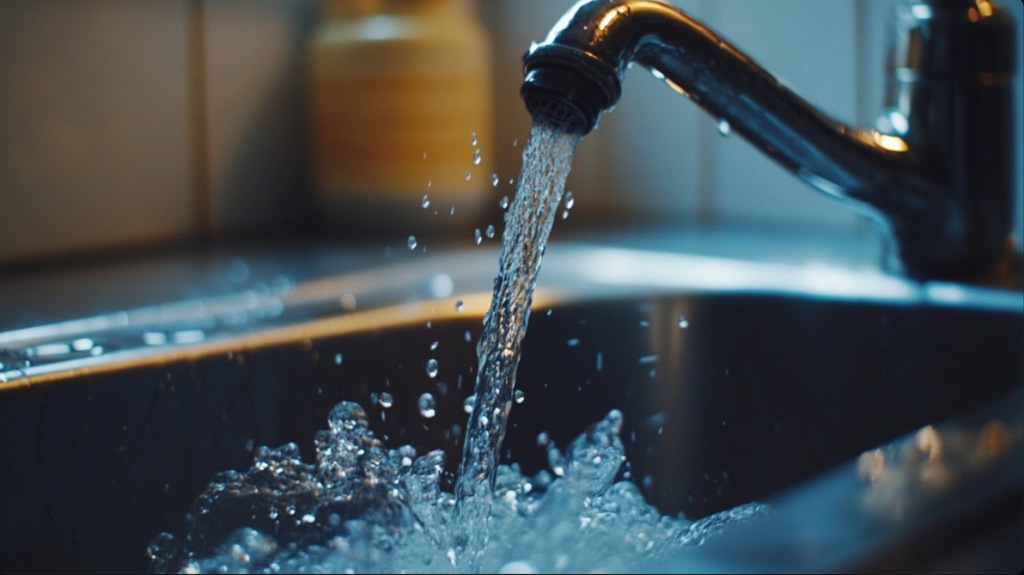No products in the cart.
No products in the cart.
For decades, communities have debated the addition of fluoride in drinking water. Supporters say it prevents tooth decay and improves public health. Critics, however, raise concerns about safety and potential health risks. So, is fluoride in water good or bad? The answer isn’t simple and depends on weighing its proven benefits against the questions still surrounding its use.
Fluoride forms a compound with fluorine, which is renowned for its reactivity. Over the years, it has gained recognition for its impressive ability to prevent tooth decay, thus making it an integral part of numerous global public health drives.
Nature is a significant contributor to our fluoride intake. This mineral is naturally found in environmental sources like water, soil, and the air we breathe due to the weathering and breakdown of rocks and minerals rich in fluorine. It is fascinating to note that the level of fluoride in the water can vary immensely due to geological factors.
In parts of Africa and Asia, natural fluoride concentrations in water can sometimes exceed the safety thresholds recommended by health authorities. Excessive levels of fluoride can lead to health complications such as dental and skeletal fluorosis, a condition that causes a change in the bone structure and severe joint pain.
Aside from being present naturally, fluoride is also added to municipal water supplies by humans, a process known as water fluoridation. The topic of water fluoridation has been controversial and subject to debate for several decades. It doesn’t go without saying that the artificial addition of fluoride into water supplies requires careful monitoring.
In the United States, the Environmental Protection Agency (EPA) has the responsibility of maintaining fluoride levels to balance dental protection with the prevention of side effects like fluorosis. Despite its potential health benefits, the practice of fluoridation continues to be seen as debatable. Proponents attribute the improvement of oral health in millions to this practice, but critics question its potential long-term effects and the ethical question of whether or not its addition should be a matter of personal choice.
Fluoride is a naturally occurring mineral found in the earth’s crust. It’s a compound of fluorine, one of the most reactive elements in nature. Renowned for its ability to prevent cavities, fluoride has been a centrepiece of public health initiatives globally. But where does it come from, and how does it end up in our water? Let’s examine its natural and artificial sources.
Fluoride isn’t something invented—it’s a substance found in our environment. It appears naturally in water, soil, and air due to the breakdown of rocks and minerals containing fluorine. Its levels in water vary based on geological factors.
Natural fluoride concentrations in water range widely. In regions like parts of Africa and Asia, levels can exceed safety thresholds, leading to concerns like dental and skeletal fluorosis.
Apart from its natural presence, fluoride is also artificially introduced into municipal water supplies. This process, known as water fluoridation, has sparked debates for decades.
Artificially added fluoride is carefully monitored. In the United States, the Environmental Protection Agency (EPA) regulates fluoride levels to balance dental protection with the prevention of side effects like fluorosis.
The practice of fluoridation remains controversial. While it’s credited with improving oral health in millions, some argue about potential long-term effects and whether its addition should be a matter of personal choice.

Fluoride in drinking water has long been recognized as a cornerstone of public health initiatives. Its benefits extend beyond oral care and touch on economic implications that affect individuals and society alike. Let’s explore how fluoride works to promote healthier teeth while reducing financial burdens.
Fluoride is best known for its role in preventing tooth decay, making it a trusted ally in dental care. But how does it accomplish this? Fluoride strengthens tooth enamel, the outer protective layer of your teeth, making it more resistant to acid attacks from bacteria and sugar. Think of it as a protective shield for your teeth.
Beyond protection, fluoride can even repair the early stages of tooth decay. It promotes remineralization, a process where minerals like calcium and phosphate redeposit into weakened enamel. It’s like patching up small gaps before they become major problems.
Fluoridated water is particularly beneficial for children, whose teeth are still developing. Studies show that communities with fluoridated water experience significantly lower rates of cavities. In fact, the CDC credits water fluoridation with reducing tooth decay by up to 25% in children and adults.
Did you know fluoride in water can also save you money? Dental care can be expensive, especially when it comes to treating cavities. By preventing tooth decay, fluoridation reduces the need for costly dental treatments.
Studies have consistently shown that fluoridated water systems lower overall dental costs for communities. For every dollar spent on water fluoridation, cities save an estimated $38 in dental treatment expenses. That’s a significant return on investment!
For families, this means fewer painful dental visits and more affordable care. It also helps those who may not have access to regular dental services. Fluoride acts as an “equalizer,” offering protection regardless of income or access to dentists.
Fluoride provides more than healthier teeth—it contributes to stronger communities by lessening the physical and financial burdens of dental issues.
Fluoride’s role in public water systems has stirred debate for decades. While widely celebrated for preventing cavities, concerns about its potential risks and environmental effects spark ongoing discussions. It’s a topic that combines health, science, and ethics—leaving communities divided.
The most discussed issue with fluoride revolves around its possible health risks. Critics argue that excessive fluoride consumption may lead to adverse effects, even at the levels deemed safe by regulatory bodies. But what exactly are these concerns?
Fluoride affects individuals differently, depending on their age, health, and overall fluoride exposure. For most, regulated levels in water are safe. However, the risks underscore the importance of monitoring intake from all sources, including toothpaste, processed foods, and beverages.
Fluoride’s impact on the environment also raises eyebrows, particularly around its contribution to ecological imbalances. Like most chemicals, fluoride doesn’t simply vanish once it’s introduced into water systems.
Many argue that fluoride’s environmental effects deserve closer attention. While the focus often remains on human health, understanding how fluoride alters ecosystems provides a broader picture of its long-term impact.
These concerns keep fluoride at the centre of an ongoing conversation. Balancing its dental health benefits with possible risks—both personal and environmental—is a challenge that communities and scientists continue to navigate. Fluoride may safeguard your smile, but it also comes with unanswered questions.
Fluoride in drinking water is tightly regulated to ensure safety and effectiveness. These measures are designed to maintain a balance—enough fluoride to prevent tooth decay without causing harm. However, guidelines and regulations are not uniform across the globe, and even within countries, they can vary significantly. Understanding these standards helps frame the ongoing debate about fluoride’s role in public health.
To protect public health, national health organizations set fluoride guidelines based on extensive research. These standards dictate safe fluoride levels in public water systems. For example, in the United States, the Environmental Protection Agency (EPA) sets a maximum fluoride level of 4.0 milligrams per liter (mg/L) to prevent health risks such as skeletal fluorosis.
The Centers for Disease Control and Prevention (CDC), however, recommends a much lower concentration for community water fluoridation—0.7 mg/L. This is considered the optimal level to reduce tooth decay while minimizing the risk of dental fluorosis. These recommendations are regularly updated to reflect new research and public health needs.
Globally, fluoride limits vary. The World Health Organization (WHO) suggests a fluoride concentration of 1.5 mg/L in drinking water as a safe upper limit. This margin accounts for regional variability in natural fluoride levels and overall exposure from other sources like toothpaste or food.
Adherence to these standards is key, but not all regions have the resources to monitor and adjust fluoride levels consistently. In nations with less infrastructure, natural fluoride levels may surpass recommended limits, exposing residents to potential health risks.
Local governments often have the final say in implementing fluoride guidelines. In some communities, fluoride is added to water systems as part of public health campaigns. In others, it is avoided altogether due to public opposition or natural fluoride presence already reaching permissible levels.
For example:
Such differences highlight how fluoride policies are shaped by local conditions, resources, and public sentiment. These variations mean that while one community may benefit from fluoridation, another might face risks related to overexposure.
Ultimately, navigating fluoride regulations requires balancing public health priorities with regional needs. While national and global standards provide a framework, local governments must tailor their approaches to ensure safety and effectiveness for their populations.
While fluoridation has played a significant role in dental health strategies, many communities consider alternatives due to health, environmental, or ethical concerns. Whether by avoiding fluoride exposure or exploring non-fluoridated methods to care for teeth, there are practical options available. Let’s examine these alternatives in detail.
For those seeking to reduce fluoride intake, safe drinking water options exist even in regions where fluoridation is common. Here are some accessible choices:
When selecting non-fluoridated water, balance convenience with health factors like mineral content and cost. Each method offers unique benefits, but understanding your household’s needs will guide you to the best decision.
Fluoridated water isn’t the only way to prevent cavities. Modern dental care offers many effective options to maintain oral health without relying on fluoride:
By combining these methods, individuals can confidently maintain their oral health without relying on fluoride. Whatever approach works best for you, consistency is key to enjoying healthy teeth for life.
Clean, filtered water is a necessity, but buying bottled water is both costly and wasteful. With growing concerns about fluoride and other additives in water, more people are turning to sustainable ways to ensure their drinking water is safe. Here’s how you can drink clean water at home, save money, and avoid the environmental impact of single-use bottles.
CLICK HERE to see what we use at home
Filtering water at home is more accessible than ever, thanks to advancements in filtration technologies. Here are some common methods you can use:
These solutions provide flexibility based on your home setup and budget while eliminating the need for bottled water.
Switching to filtration systems also allows you to reduce plastic waste by using reusable water bottles or containers. Not only is this eco-friendly, but it’s also cost-effective. A one-time investment in a durable water bottle saves money over time compared to constant purchases of bottled water.
Reusable options encourage healthy hydration habits while helping the planet.
For individuals concerned about fluoride specifically, reverse osmosis (RO) systems are among the most effective options. These systems use a multi-step process to remove fluoride, along with other contaminants like lead, arsenic, and chlorine. RO systems often consist of:
While the upfront cost of an RO system may seem high, the long-term savings and health benefits outweigh bottled water expenses. RO systems fit under the sink or on the countertop, offering convenience for daily use.
Some filtration methods, like reverse osmosis and distillation, also remove beneficial minerals like calcium and magnesium. But don’t worry; there are ways to reintroduce these to your water:
These small steps make sure your filtered water stays as healthy as it is clean.
By investing in home filtration, you can have peace of mind about what you’re drinking without the hassle or cost of continuous bottle purchases.
Fluoride in drinking water sparks ongoing debate, with valid arguments on both sides. Its benefits for dental health and cost-saving advantages are well-documented. However, concerns about overexposure, environmental effects, and personal choice persist.
The key is balance. Communities must weigh the proven benefits of fluoride against its potential risks. Whether supporting fluoridation or seeking alternatives, understanding the science and staying informed empowers better decisions.
What’s your stance? Consider the needs of your household and community, and use this knowledge to advocate for what’s best.
If you need any further information or assistance with this article, don’t hesitate to Contact Us
Karen Blake
BAHN-NLP
TFT-DX



